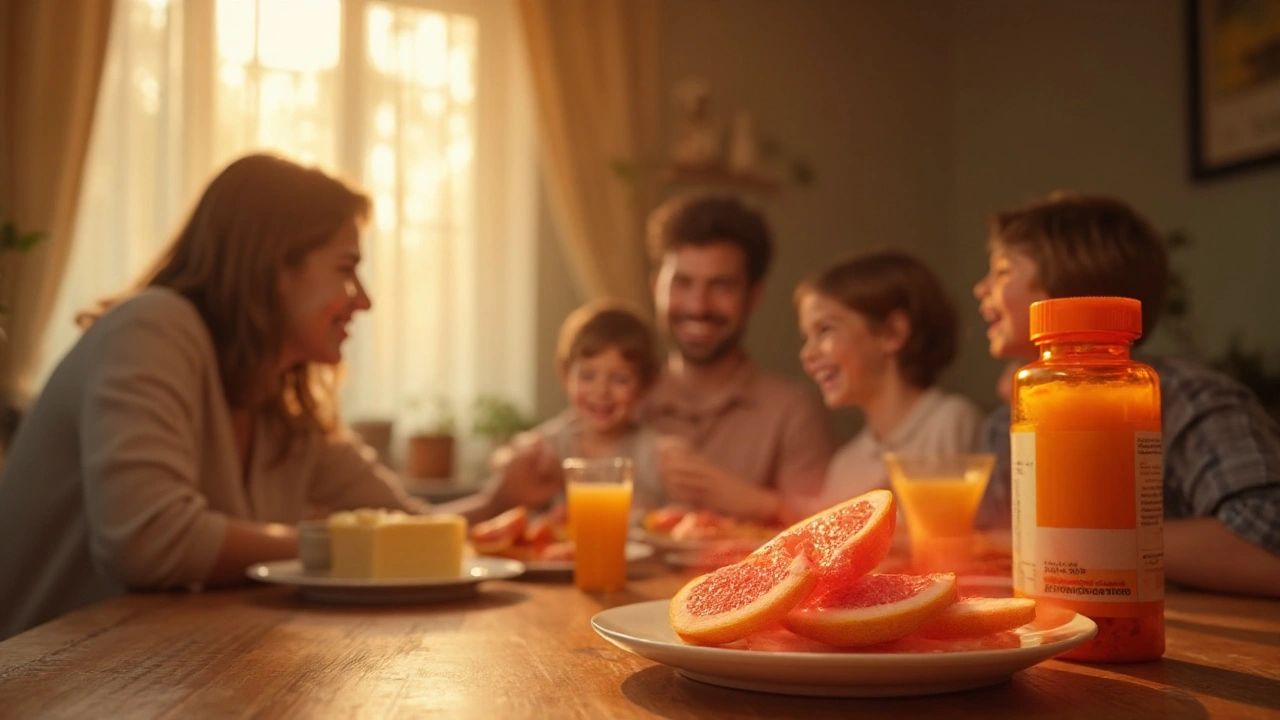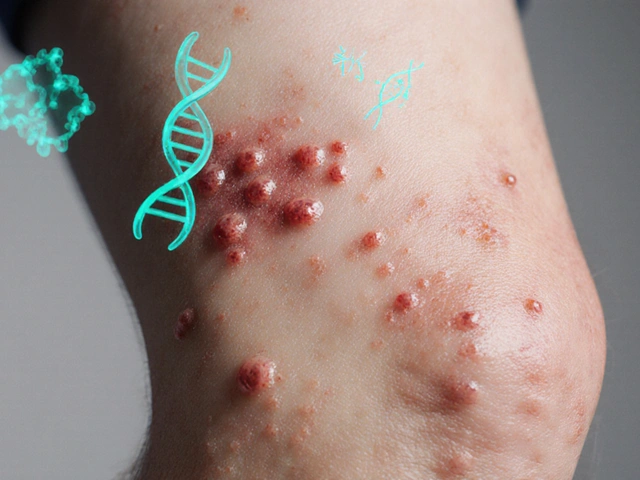Atorvastatin is a synthetic lipid‑lowering medication belonging to the statin family, used to reduce LDL‑cholesterol and lower cardiovascular risk. While it’s a workhorse in cardiology, its reliance on liver enzymes makes it a frequent victim of drug interactions. Below you’ll find a step‑by‑step plan to keep those interactions at bay, whether you’re a patient managing your own prescriptions or a pharmacist reviewing a new order.
How Atorvastatin Is Processed in the Body
Atorvastatin is primarily metabolised by the enzyme CYP3A4 (cytochrome P450 3A4), a liver enzyme that breaks down many oral drugs. When another substance either blocks or speeds up CYP3A4, plasma levels of atorvastatin can spike or dip, leading to reduced efficacy or heightened side‑effects such as muscle pain, liver enzyme elevations, and in rare cases, rhabdomyolysis.
Common Culprits That Heighten Interaction Risk
Not every co‑prescribed drug is dangerous, but a handful are notorious for interfering with CYP3A4. Knowing them helps you ask the right questions.
- Simvastatin another statin that shares the same metabolic pathway - co‑administration can double the risk of muscle toxicity.
- Lovastatin a naturally derived statin also cleared by CYP3A4 - similar concerns as with simvastatin.
- Gemfibrozil a fibrate that inhibits statin metabolism and raises muscle‑damage risk.
- Clarithromycin a macrolide antibiotic and strong CYP3A4 inhibitor.
- Warfarin an anticoagulant whose effect can be altered by changes in liver enzyme activity - monitor INR closely.
- Grapefruit juice a fruit extract that potently blocks CYP3A4 in the gut - even a single glass a day can raise atorvastatin levels by up to 50%.
Other medicines such as amiodarone, azole antifungals, and certain HIV protease inhibitors fall into the same category, but the list above covers the most frequent encounters in primary care.
Practical Steps to Reduce Interaction Danger
- Maintain an up‑to‑date medication list. Write down every prescription, over‑the‑counter product, supplement, and even regular food items like grapefruit.
- Ask your pharmacist to run a drug‑interaction check. Most community pharmacies have software that flags CYP3A4‑related problems in real time.
- Schedule blood tests. Baseline liver function tests (ALT, AST) and creatine kinase (CK) help spot early toxicity. Repeat them 4‑6 weeks after any dose change or new medication.
- Adjust the dose if needed. When a strong CYP3A4 inhibitor must be used, clinicians often halve the atorvastatin dose or switch to a statin less dependent on CYP3A4, such as pravastatin.
- Watch for symptoms. New muscle aches, weakness, or dark urine should trigger an immediate call to the prescriber.
- Limit grapefruit. If you love the fruit, keep it away from the times you take your statin - at least 8hours apart.
- Consider alternative therapies. For patients on multiple interacting drugs, non‑statin lipid‑lowering agents (e.g., ezetimibe) may be safer.
Leveraging Tools & Professional Support
Technology can take a lot of the guesswork out of the process.
- Online drug‑interaction checkers. Websites maintained by governmental health agencies provide free, evidence‑based interaction reports.
- Mobile apps. Apps like Medisafe or MyTherapy let you log meds and automatically warn of known conflicts.
- Electronic health records (EHR). If you’re seeing a GP, ask whether their system alerts to statin‑CYP3A4 interactions - most modern EHRs do.
- Consult a clinical pharmacist. Pharmacists specialise in medication safety and can recommend dose tweaks or safe alternatives.

Comparison of Interaction Profiles
| Statin | Primary Metabolic Pathway | Known Strong CYP3A4 Inhibitors | Typical Dose‑Adjustment Guidance |
|---|---|---|---|
| Atorvastatin | CYP3A4 | Clarithromycin, grapefruit juice, itraconazole, ritonavir | Reduce dose by 50% or switch to pravastatin |
| Simvastatin | CYP3A4 | Same as atorvastatin | Half dose or avoid strong inhibitors altogether |
| Lovastatin | CYP3A4 | Same as atorvastatin | Same as simvastatin |
| Pravastatin | UGT1A3 (minimal CYP involvement) | Rarely affected | No routine dose change needed |
Lifestyle Tweaks & Ongoing Monitoring
Even with perfect medication management, lifestyle plays a big part in how your body handles statins.
- Stay hydrated. Adequate water helps kidneys clear any excess metabolites.
- Exercise regularly. Physical activity can improve muscle health, reducing the chance that a mild CK rise becomes clinically relevant.
- Balanced diet. A heart‑healthy diet low in saturated fats supports the cholesterol‑lowering goal, possibly allowing a lower statin dose.
- Avoid excessive alcohol. Alcohol can stress the liver and amplify any drug‑induced liver‑enzyme spikes.
Schedule follow‑up appointments every 3-6 months, or sooner if you add a new medication. Keep a copy of your latest lab results handy for each visit.
Quick Checklist to Minimise Atorvastatin Interactions
- Write down every drug, supplement, and food item you consume.
- Tell your pharmacist about all of them; request an interaction screen.
- Get baseline liver and CK labs; repeat after any change.
- Avoid grapefruit juice (or keep a safe time gap).
- If prescribed a strong CYP3A4 inhibitor, discuss dose reduction or a switch to pravastatin.
- Monitor for muscle pain, weakness, or dark urine.
- Use a medication‑tracking app for reminders and alerts.
By following these steps, you dramatically cut down the odds of a nasty atorvastatin interactions episode and stay on track to lower your heart‑disease risk.
Frequently Asked Questions
Can I take ibuprofen with atorvastatin?
Ibuprofen does not affect CYP3A4, so it’s generally safe. However, chronic NSAID use can strain kidneys, which may indirectly affect statin clearance. Keep doses low and stay hydrated.
Is it okay to switch from atorvastatin to pravastatin if I’m on a macrolide antibiotic?
Yes. Pravastatin is cleared mainly by the UGT pathway and does not rely on CYP3A4, making it a safe alternative when you need a strong CYP3A4 inhibitor like clarithromycin.
What lab tests should I monitor while on atorvastatin?
Baseline and periodic liver enzymes (ALT, AST), creatine kinase (CK) for muscle safety, and fasting lipid panel to gauge efficacy. If you start a new interacting drug, repeat labs within 4‑6 weeks.
Does grapefruit juice affect all statins?
Only statins that depend heavily on CYP3A4 - atorvastatin, simvastatin, and lovastatin - are significantly impacted. Pravastatin, rosuvastatin, and fluvastatin are largely unaffected.
I’m 78 years old. Do I need extra precautions?
Older adults often have reduced liver metabolism and are more prone to muscle toxicity. Start at the lowest effective dose, review all meds carefully, and monitor labs more frequently (every 3 months).
Can herbal supplements like St. John’s wort interact with atorvastatin?
St.John’s wort induces CYP3A4, which can lower atorvastatin levels and reduce its cholesterol‑lowering effect. Avoid it or discuss dose adjustments with your doctor.






Comments
Anna Graf
21/Sep/2025Life is a river and each pill we take is a stone that can smooth or scar the bank. Atorvastatin is a powerful stone, but it can grind against the currents of other medicines. Knowing the path of that stone helps us keep the water clear. A simple list of everything you ingest is like a map of the riverbed. Keep that map updated and you will avoid hidden rapids.
Jarrod Benson
21/Sep/2025Alright, let me break this down for you because staying safe with statins is a marathon, not a sprint. First, grab a notebook or a phone app and jot down every medication, supplement, and even that morning grapefruit you love – yes, that fruit is a sneaky enzyme blocker. Next, head to your pharmacy and ask the pharmacist to run a full interaction check; they have software that will flag any CYP3A4 villains lurking in your regimen. If you see a red flag, don’t panic – most doctors will simply cut your atorvastatin dose in half or swap you to something like pravastatin that doesn’t depend on that enzyme. Keep your baseline labs – liver enzymes and CK – on hand because they are the early warning lights that tell you if something’s off. Schedule a repeat panel 4 to 6 weeks after any medication change; catching a rise in CK early can prevent serious muscle damage. Drink plenty of water; staying hydrated helps your kidneys flush out metabolites before they build up. Exercise regularly but listen to your body – any new muscle aches that linger should raise a flag. When you’re on a strong CYP3A4 inhibitor like clarithromycin, remember to separate the dosing times from your statin by at least eight hours; timing matters. If you’re on multiple interacting drugs, consider a non‑statin option such as ezetimibe or a PCSK9 inhibitor – there are alternatives that don’t play the same enzymatic games. Talk to your clinician about the possibility of using a lower statin dose if you’re older or have liver issues; the elderly often need gentler starts. Avoid heavy alcohol consumption because it can stress the liver further and amplify any drug‑induced bumps. Keep an eye on your diet – a heart‑healthy low‑saturated‑fat plan can sometimes allow you to stay on a lower statin dose while still reaping the cholesterol‑lowering benefits. Lastly, don’t forget to set reminders in your phone or a pill‑tracking app; consistent timing helps maintain steady blood levels and reduces surprise spikes. In short, awareness, communication, and monitoring are your triple‑threat against nasty interactions, and with these steps you’ll keep your heart and muscles happy.
Liz .
21/Sep/2025good stuff i love the vibe here keep it simple and real we all need that clear checklist without the jargon lol
tom tatomi
21/Sep/2025while many accept the checklist as gospel I wonder if the focus on grapefruit alone distracts from bigger issues like polypharmacy and hidden herbal extracts
Tom Haymes
21/Sep/2025It’s great to see the enthusiasm, but remember that every patient’s situation is unique. A supportive approach means encouraging them to talk openly with their prescriber about any concerns. Think of the medication list as a conversation starter, not a final verdict. By fostering trust, you empower them to flag side‑effects early and adjust therapy responsibly.
Scott Kohler
21/Sep/2025Ah, the so‑called “official” guidelines-crafted by the same shadowy cabal that decides which drugs make it to market while conveniently ignoring the covert influence of big pharma’s lobbyists. Of course, they whisper about grapefruit, yet they never mention the clandestine firmware updates in pharmacy software that silently suppress interaction alerts, ensuring patients remain blissfully unaware. One must question whose interests truly drive these recommendations.
Brittany McGuigan
21/Sep/2025We must protect our nation’s health from foreign med interference.
Priya Vadivel
21/Sep/2025Honestly, I feel so grateful, truly, for everyone sharing their knowledge-your insights are invaluable, especially when navigating the complex world of statins, and I hope you’ll continue to post these thorough guides, because patients like me depend on clear, compassionate explanations; thank you so much for dedicating your time, it really makes a difference.
Dharmraj Kevat
21/Sep/2025Drama unfolds when a simple pill collides with a hidden antagonist-cue the suspense, the stakes are high, the hero must act.